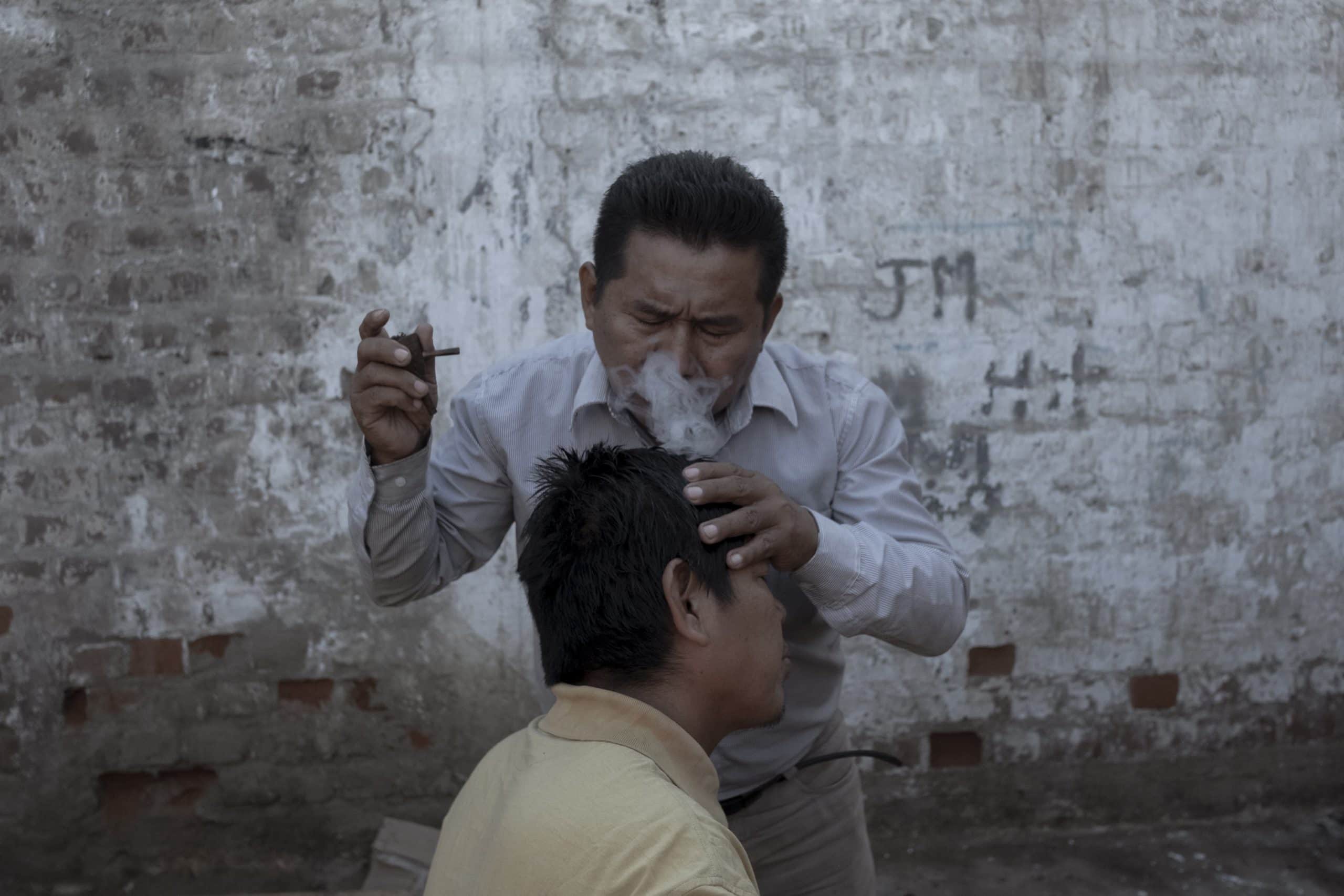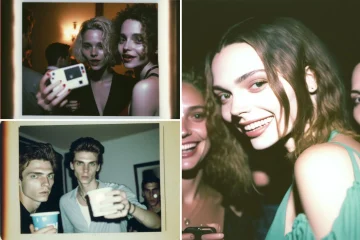

Overlooked by the Cerro San Cristobal mountain in Lima, Peru, there is a cluster of grey corrugated roofs rising from the arid land of Lima’s urban center. This is Cantagallo Island, home to the Shipibo-Conibo Indigenous community, which migrated from the rainforest to the city in search of better opportunities.
However, with COVID-19 the health of the entire community is at risk with 80% of the inhabitants infected by the virus. Despite the unsanitary conditions – no drinking water, no drainage or access to basic supplies – they receive minimal support from the government and have turned instead to the knowledge and traditions brought with them from the Amazon.
Through a series of sensitive images, photographer Florence Goupil* presents an illuminating insight into both the challenges and blessings of living in a close community, balancing the impossibility of maintaining social distancing in the narrow streets and crowded living spaces, with the value of community support during a pandemic.
*This project was supported by the COVID-19 Emergency Fund for Journalists.

Florence, how did this project come about?
Cantagallo Island is a Shipibo-Conibo Indigenous community founded in 2000 in the urban center of Lima, Peru. Today, there are more than 300 Shipibo-Conibo families that migrated from the rainforest.
At the end of 2016, a fire destroyed their community and for almost four years they were waiting for the Peruvian government to rebuild their houses, build streets and install piped water. But these projects were never realized and at the beginning of this year, the Shipibo-Conibo returned to the community to precariously rebuild their houses.
My friends Gabriel Senencina and his wife Celinda Cahuaza asked me to tell their stories to make their situation visible
However, a state of emergency was declared in response to COVID-19 and the Indigenous families found themselves crammed into an unhealthy terrain with no access to drinking water or basic services for surviving the quarantine.
My friends Gabriel Senencina and his wife Celinda Cahuaza asked me to tell their stories to make their situation visible. Lacking income and basic necessities, their health was at risk. The Peruvian State did not present any contingency plan to protect the vulnerable communities. It was then that I decided to do a report on the unhealthy conditions of their quarantine and how the Indigenous people found refuge in their traditional herbal medicine.
ArrayHow did you first come across the Cantagallo Island community – are they widely known in Lima?
I met the Shipibo-Conibo people at least nine years ago. I like to tell it as an unexpected encounter. As someone who marvels at the sporadic visit of a hummingbird in the desert, I met Gabriel Senencina. One afternoon, I was visiting a neighbor and as I walked into his living room, I came across a man with long black hair and a deep stare sitting on the couch.
Following the tragic fire, many artists expressed solidarity with the Shipibo-Conibo and now their artwork is much more visible and valued
Since then we’ve become friends and as the years went by, I was able to gradually visit first the community of Cantagallo Island and then the Indigenous communities in the Peruvian Amazon.
At that time, the Indigenous community of Lima was not well known and for many years they were marginalized. Following the tragic fire, many artists expressed solidarity with the Shipibo-Conibo and now their artwork is much more visible and valued in Lima, and worldwide.

You mention in your project text that 70% of the inhabitants are infected with COVID-19. Why is the infection rate so high? How does this compare to the rest of the city?
First, because of the inequality. In Peru, not all citizens can make a dignified quarantine. To live in quarantine in an Indigenous community – isolated in the middle of an urban area without access to running water or basic services – can be dangerous for people’s health.
They cannot wash themselves often, as water is scarce. Many families have no income since they depend on ambulatory work, nor do they have refrigerators or a way to store food, so they must go out in search of it.
In the Indigenous Amazonian culture, the concept of isolation and social distancing is very difficult to adopt
But despite the conditions in the community, the Peruvian State didn’t present a contingency plan to protect the indigenous communities in the country. There was very little information in their native language about the virus and how to prevent contagion.
Furthermore, it’s important to know that in the Indigenous Amazonian culture, the concept of isolation and social distancing is very difficult to adopt, as their relationships are based upon contact. They live in a community as one big family and it’s normal to see them visit each other to have meals together. If one of the family members is ill, the rest of the family is ready to accompany and watch over him or her. This is part of their cosmovision and way of life.

What can you tell us about the Shipibo-Conibo community?
The Shipibo-Conibo arrived in Lima in search of better opportunities and jobs, as well as better education for their children. Their willingness and curiosity to understand and get closer to the Western world led them to leave the Amazon forest to live in a city of 11 million inhabitants.
Since then, they’ve learned how to adapt to the Western Peruvian culture, learned how the economy works in the city and how to live with no forest. But they have always kept their traditions, their cosmovision and their roots. It is perhaps their desire to create a bridge between these two worlds that best characterizes them.
With the arrival of COVID-19, this mistreatment of Indigenous peoples became very evident and serious
However, the world of Lima has not learned how to adapt to them. They have been discriminated against, mistreated for being indigenous, for their appearance and for the stereotypes that come with the knowledge of medicinal plants. With the arrival of COVID-19, this mistreatment of Indigenous peoples became very evident and serious.
Today in Peru, the Shipibo-Conibo are vulnerable to this pandemic. In my opinion, there is a reason why they’re now living in the Western world. Perhaps if they’d never come to Lima, we would never have met them. I feel lucky to have the chance to know them, because through them I’ve learned about the rainforest, about the relationship with nature and, above all, that we should take care of the environment. There are people who can teach us to take such care, and those are the Shipibo-Conibo.

Is the government helping them in any way? Who is able to get tested for COVID-19 – is everyone entitled to it or only a select few?
On May 12, almost two months since the health emergency and social isolation began, a team of nurses from the Peruvian Ministry of Health arrived at the community of Cantagallo Island to carry out 1,000 rapid tests in an effort to identify and stop the spread of the COVID-19 virus. This happened after the death of two Shipibo-Conibo Indigenous people.
The next day, the Minister of Health imposed a quarantine on the native community, guarding it with military force
The Peruvian State’s rapid tests are free and part of President Vizcarra’s sanitary plan. The next day, the Minister of Health imposed a quarantine on the native community, guarding it with military force. Orders were given that no one would leave or enter and a nurse was assigned to care for the more critical cases.
On May 15th, President Vizcarra said that Peru had carried out 600,000 coronavirus rapid tests. However, the molecular tests are not for free and are administered by private clinics.

In your project, you focus on the traditional healing techniques that this community are using as palliative and preventative treatment against the virus. Is the use of these medicines a choice or simply because they have no alternative?
Since ancient times, the Shipibo-Conibo people from the Amazon forest have protected and healed themselves from diseases through the careful use of their medicinal plants. In their prescriptions, they say, they include certain Western medicines such as metamizole, dexamethasone, gentamicin and diclofenac, but in the current context of isolation they haven’t been able to obtain them.
I can say that we have a deeper bond of friendship as a result
With the arrival of the new virus and the lack of a contingency plan from the Peruvian government to protect the most vulnerable communities, the indigenous people found refuge in their medicinal plants once again.
How did you get such intimate access to the community, and how were you able to document this story in a safe way?
With the help of Gabriel Senencina and his wife Celinda Cahuaza. We have worked on environmental projects before, and we’ve traveled many times together to the Amazon to visit their home communities. I can say that we have a deeper bond of friendship as a result.

At first, I started to photograph the unhealthy conditions of the community, until I suddenly realized they were trying to show me the remedies they found in the plants. It is thanks to them that I was able to make a reportage closer to their cosmology.
But also, it was the community who showed me which plants they protect themselves with, and how they use them to prevent the virus. I allowed myself to be led by the community leaders, even though I was afraid of making a mistake and getting out of context. Later, I understood that, as Indigenous people, they find refuge in plants and it felt important to show this bond.
It’s important not to impose a Western vision on them, with respect towards the Indigenous peoples
The method of prevention was never very accurate as the virus is new. But we always try to keep a physical distance and wear masks at all times. The Shipibo-Conibo gave me instructions on how to protect myself with the plants. So every afternoon, I returned home with medicinal plants and recipes from the Amazon. My family thought I’d gone out of my mind, but eventually they accepted the natural recipes.
Your pictures have a sensitivity about them and your respect towards the subjects shows. What advice would you give photographers covering difficult issues such as this?

As photojournalists, it’s important not to impose a Western vision on them, but to maintain a horizontal dialogue, with respect towards the Indigenous peoples. For me, the best path to understand other ways of living is to leave ours aside for a moment.
What was the biggest challenge you faced while shooting this project?
Losing my friends. I witnessed how the disease progressed and many of the Shipibo-Conibo were sick and suffering from the symptoms of the virus. The death toll was rising in Peru, so I was afraid of losing one of my friends in the community. On May 11th, Juan Agustin’s nephew died. That day, I saw a community cry.
On May 11th, Juan Agustin’s nephew died. That day, I saw a community cry
Lastly, why was it important for you to tell this story?
Indigenous peoples are very vulnerable to the arrival of the new virus, mainly because governments do not protect them and because their way of life is never taken into account when health protocols are created. In other words, there is no cultural approach to protecting the life and worldview of the Indigenous people.
Cultural diversity is what sustains this world. We must protect this diversity. It is very important to know who the Indigenous people are, how they relate to their environment and how they try to survive in this Western world, so as not to be indifferent to their existence and to let them live freely.




